Underclothes and Small Kit Items
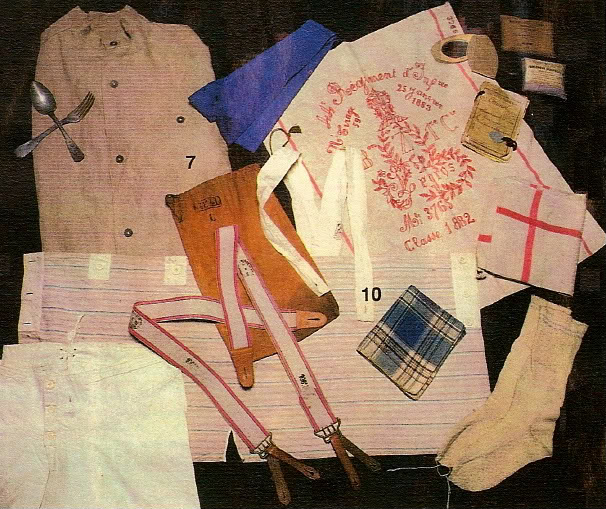
Underclothes and small kit items, including a 1914 flannel waist belt with cloth suspenders, a pair of regulation braces, a small kit bag, a regulation blue-checkered handkerchief, a hand towel and a pair of linen socks.
la Cravate ("neck tie"): calico; marine blue; 150 cm x 21 cm. It is folded in thirds and tied with a flat knot. (See image below)
la Chemise ("shirt"): model 1878, flannel cotton with collar, either pin-striped (red, black or blue), blue checkered or plain white; closed with three bone or porcelain buttons; shirt-tails on both front and rear. Each man was issued two. A lighter weight cretonne cotton shirt (plain or with blue stripes) was also issued in warmer weather.

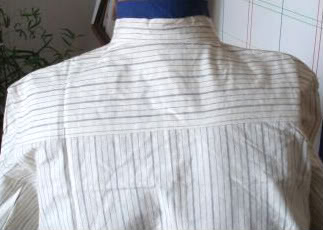
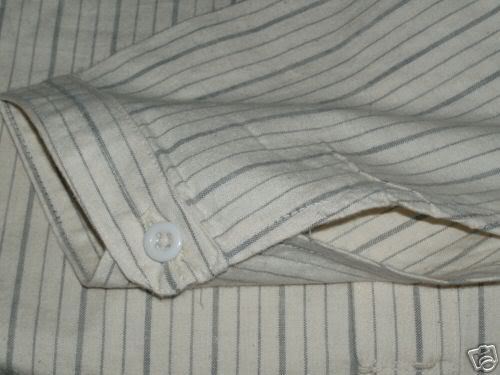 Regulation shirt.
Regulation shirt.
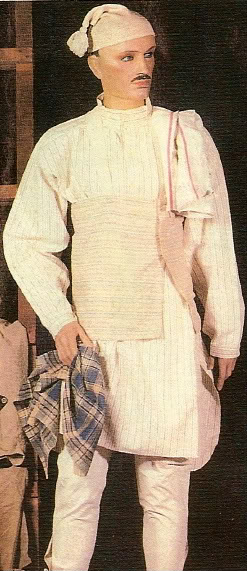
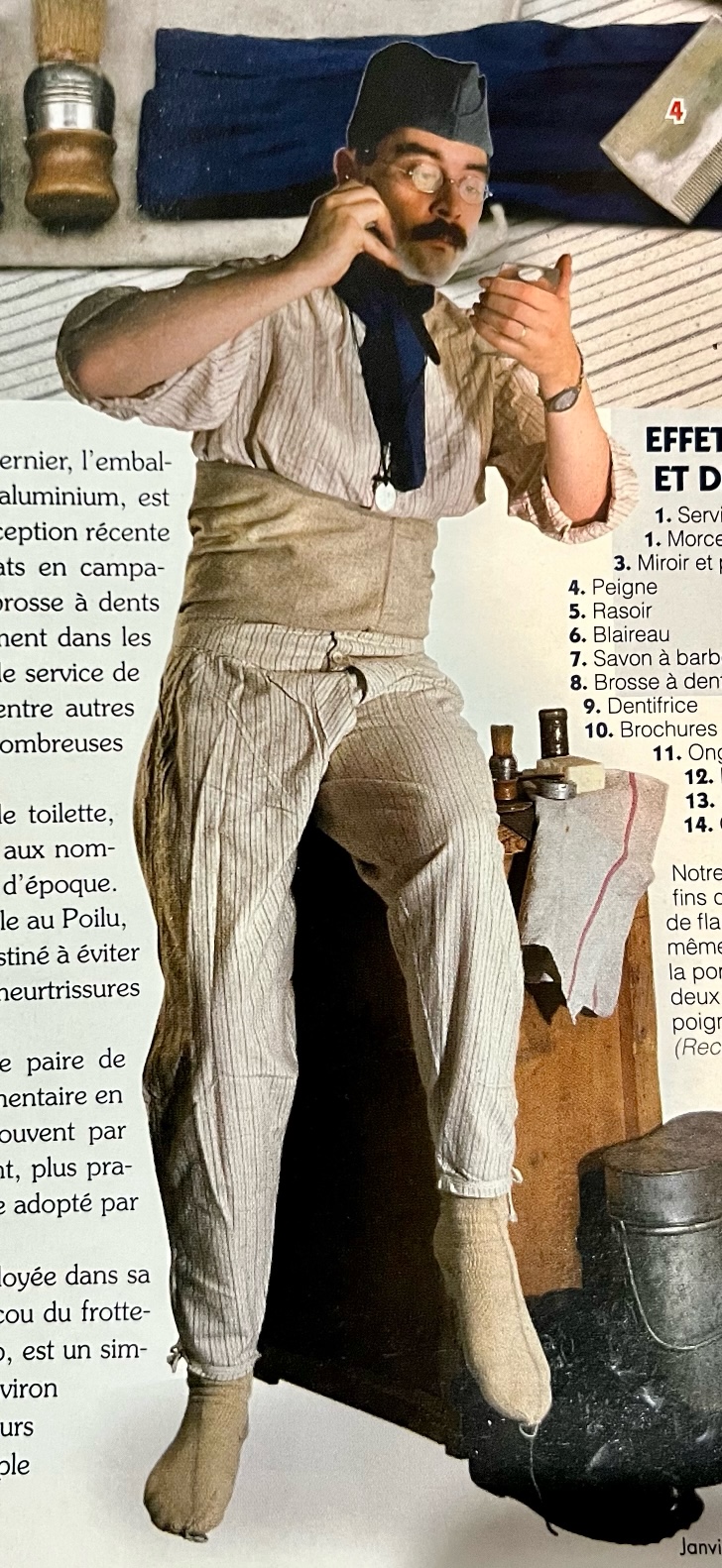
The photo on the left shows the length of the tails on the regulation shirt. The mannequin also wears a plain white regulation pair of underdrawers and the sleeping cap. The photo on the right shows a man wearing the war-time style of flannel waist belt. See descriptions below.
le Caleçon ("underdrawers"): cotton; either pin-striped or plain white. Each man is only issued one pair, though private purchases could be made. The prevailing notion was that the shirt, with its long tails, acted as the primary undergarment and was to be washed more frequently. (In cold weather, flannel cotton underdrawers were issued.)
les Bretelles ("suspenders"): Cotton thread; white with a border on each edge of a "sharp color" (e.g. pink). These were comprised of two separate braces reinforced at each end by a piece of leather where a button-hole was located. The length was adjusted by way of a metal crimp. (See image above) Soldiers often replaced these with the more advantageous single-piece civilian models also of cotton.


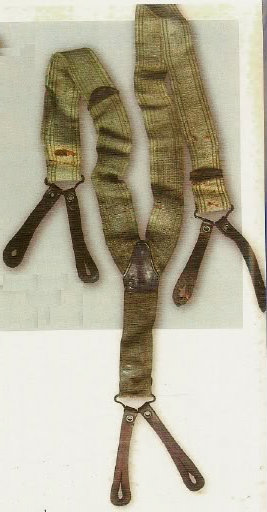
Left: regulation set of braces. Center and right: two different pairs of civilian model suspenders.
le Ceinture de Flanelle ("flannel waist-wrap"): flannel wool or cotton; 1-4 m. x 38 cm, adjusted with three buttons in bone at one end of wrap. The model first distributed in 1914, unlike the pre-war version, had interior buttons to attach cloth suspenders which were issued with the belt. However, these were usually discarded by the soldiers. In September 1914, this model is often replaced with another waist-wrap (resembling civilian models ) in either flannel cotton or wool, natural or grayish in color, referred to as the "Algerian model." It was a simple band of cloth in gray 3 meters long which was wrapped around the waist and tucked in to fit. In August 1915 a new model of wrap was officially adopted which was 4 meters long and wrapped similarly to the Algerian style. But by November of 1915, shortages in this model lead to several different models in various shades and sizes being distributed simultaneously. In August 1918, the regulation length will be reduced to 3 meters.
les Chausettes ("socks"): jean-wool in summer, wool in winter; normally white but there was no regulation color. Each man received two pairs. Many peasant soldiers opted to wear "Russian socks" (i.e. cloth foot-wraps). These were about 15 cm in width and 1 meter in length.
le Mouchoir ("handkerchief"): blue checkered cotton; 60 cm x 69 cm; two for each man. (See image above and below)
le Mouchoir d'Instruction ("instruction handkerchief"): cotton, with illustrations/text in red and black; multiple varieties, such as rifle care, diagram of full-compliment kit, etc. These handkerchiefs ceased distribution in 1909 but was held onto by reservists and territorials.
la Plaque d'Identité ("ID plaque"): model Oct. 12, 1881, nickel and later, aluminum. In 1914, only one plaque was worn around the neck, normally suspended from a black (fabric) shoelace or a leather lace. (See image below)
For more information on ID plaques, please see the 'ID Plaques and Soldier Booklets' page.
le Bonnet de Nuit ("sleeping bonnet"): cotton. Referred to as the calotte ("skull-cap"), it ceased distribution in 1908 but was held onto by reservists and territorials. (See image above)
la Fourchette et la Cuillère ("fork and spoon"): iron (polished); 20 cm long; technically the fork was not part of the field kit.
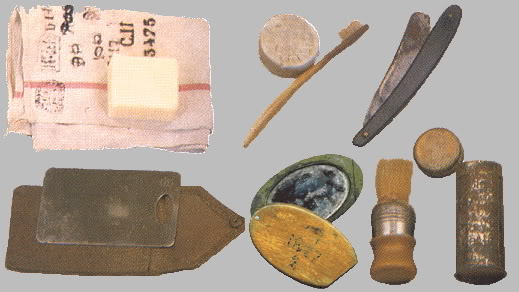
Tolietries: hand towel and soap, toothbrush and tooth powder, straight razor, two models of pocket mirror, shaving brush and brush container. All are regulation models except for the toothbrush, which was not distributed (it was not considered a necessary form of hygiene yet).
la Serviette ("hand towel"): linen; 60 cm x 69 cm; plain white ("Republican Guard model") or white with blue and yellow or red stripes on borders. (See image above)
le Savon ("soap"): plain white bar (square-shape). (See above) The ration called for each man to have 12 gm per day. However this was normally issued in one block every 15 days. The soap was used for both cleaning the body and for cleaning underclothes and small kit items. It was kept wrapped up in the towel. Another type of bar was rectangular and had "Arme Francaise" imprinted on it.
le Rasoir ("straight razor"): steel with black horn handle; referred to as the coupe-chou ("cabbage-cutter"). Safety-razors were also used but not as common. (See above)
le Blaireau ("shaving brush"): metal handle. (See above)
le Peigne ("comb"): horn; referred to as the décrassoir ("cleaner"). The preferred model was a double-sided comb.
le Mirroir ("mirror"): various models of pocket mirrors; round or rectangular model with metal backing (issued with canvas envelope) or elliptical model in wooden frame with pivoting cover. (See above)
*Note: the shaving toiletries and mirror were not issued items but were purchased by the men at military bazaars or canteens in the rear.
le Sac de Petit Monture ("small kit bag"): cotton; 40 cm x 25 cm; contained in the small kit bag were the soldier's toiletries.
la Trousse de Couture ("sewing kit"): early model in blackened leather (on the rough side); 1912 model in cachou cotton canvas (with black ribbon on borders). The kit including the following: steel scissors (14 cm), a wooden (boxwood) spool with white, black and red linen thread, an open-ended thimble (fitted onto spool) and an internal compartment for sewing needles (6) and an awl; a button kit consisting of small and large grenade buttons, zinc "Equipment Militaire" and bone buttons all sewn onto a patch of dark blue wool.
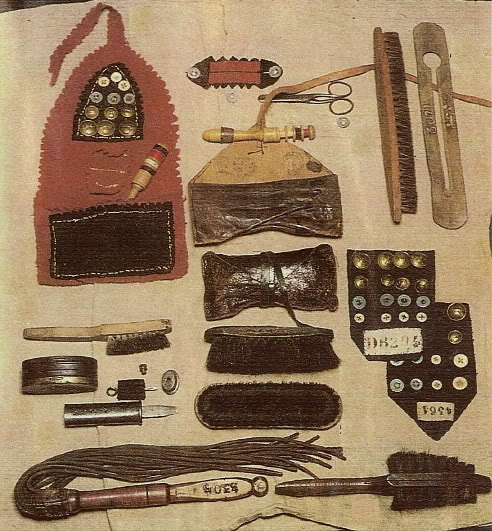
From left to right, top to bottom: a non-regulation sewing kit made of madder wool, two (leather) regulation sewing kits, button polisher brush and stick, gun brush, gun cleaning kit, double-sided tin, two clothes brushes, two button kits, martinet, and double-sided boot brush.

Gun cleaning kit, the top third of a rifle rod, gun brush, and cleaning cord.
la Patience ("button polisher stick"): wood. (See image above)
la Brosse à Boutons ("polishing brush"): wood handle (27 cm x 3.5 cm). (See image above).
la Brosse à Habit ("clothes brush"): wood handle; 17 cm x 6 cm; two distributed per squad.
la Brosse Double à Chaussure ("double-sided boot brush"): wood handle; 17 cm x 6 cm; for removing mud and polishing. Two distributed per squad. (See image above)
la Boîte Double ("double-sided tin"): tin; for shoe polish and rifle grease. At mobilization, only three were issued per squad. This distribution would be increased in October 1914 to one for each man.
le Martinet ("martinet"): clothing whip; wooden handle with leather tails; for removing dirt from clothing. (See image above)
le Nécessaires d'Arme ("gun cleaning kit"): model 1874, iron; contained within the hollow handle a scraper and a double-headed flat screw-driver head (both held in a small cloth cover). The removable head serves as an oiler. Four kits distributed per squad. Distribution of these stopped in war-time with the men using rifle ramrods instead (see below for details).
 (640x275).jpg?dl=0)
Extra thread, a later model sewing kit, boot brush, leather laces, double-sided tin with shoe polish, and double-sided brush.
la Brosse d'Arme ("rifle brush"): wood handle; 16 cm. Two brushes distributed per squad.
la Ficelle de Nettoyage ("cleaning cord"): 2.5 to 3 meters long. By fixing a piece of cloth to one end, it can be fed through the rifle to clean the barrel. It is distributed to each soldier and carried in the sewing kit.
la Baguette à Fusil ("rifle ramrod"): steel; pre-war version was made of steel with a brass head; composed of three lengths with screw tip ends. When assembled, a piece of cloth could be fixed into the slit on the open end of the rod in order to clean the rifle barrel. Initially carried on the baggage trains (16 per company), in May 1915 distribution would be reinstated for individual distribution. This version was entirely composed of steel, including the head. It was carried (disassembled) in the front enveloped of the backpack.
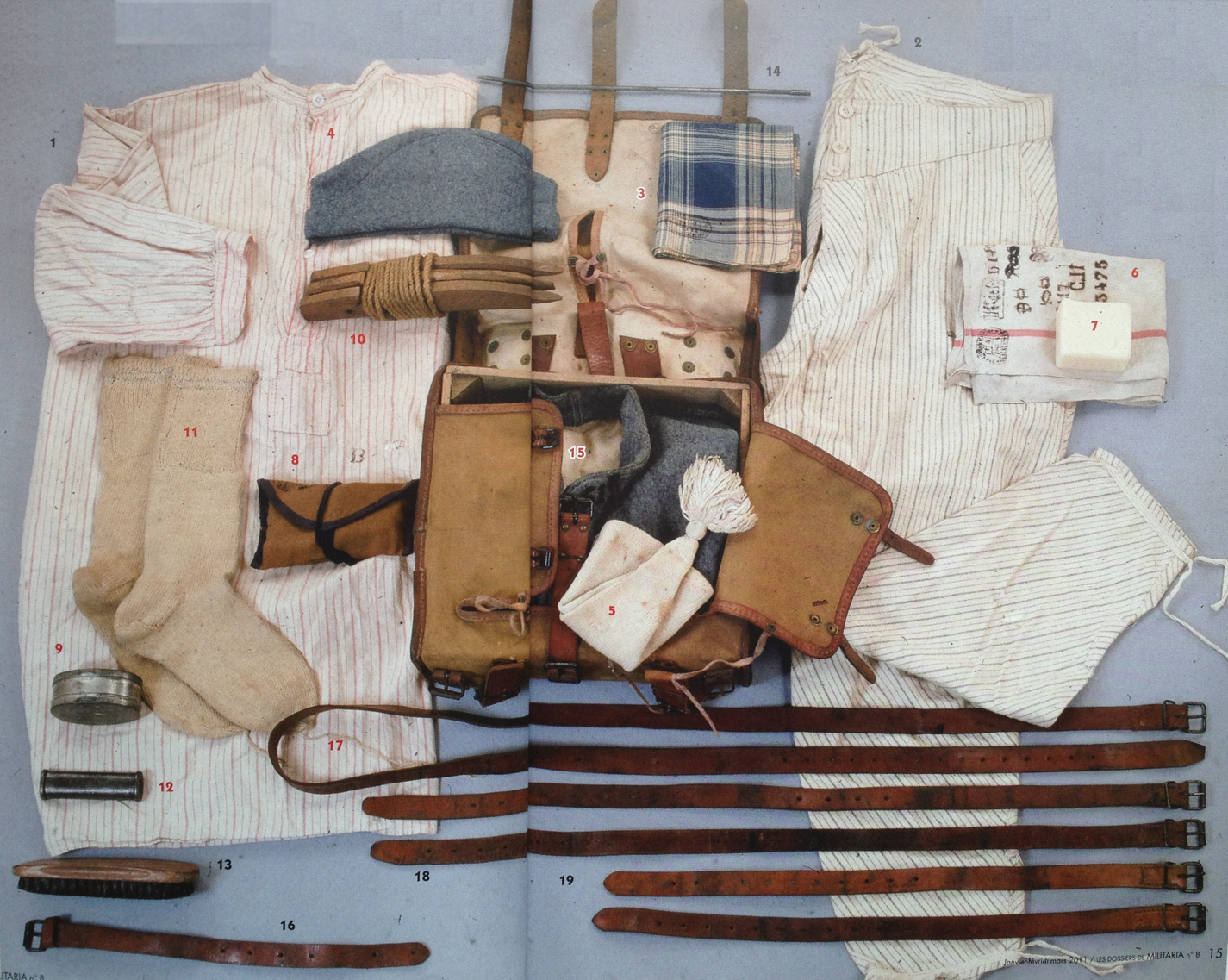
Additional examples of underclothes and small kit items.




 (640x275).jpg?dl=0)






